Onboarding is one of the most important beginning stages after a sale that a customer can go through. It’s all about setting the right foundations and setting our customers and our businesses up for success.
In this article, I’ll talk about onboarding both on a technical and strategic level, how we can flip the script for deeper impact, what onboarding is not, and I’ll finish by introducing the concept of re-onboarding.
My name's Mike Lee, I'm the Director of Customer Success at Spreedly and I'm excited to present his article about onboarding. Onboarding is an extremely important part of the customer journey, that lifecycle.
Here I get the opportunity to express to you some thoughts and some ideas that I have about onboarding. And maybe, just maybe get you thinking a little bit more about your onboarding program.
Onboarding: the key to success for SaaS products and companies
Onboarding is one of the most important beginning stages after a sale that a customer can go through or that a company can issue for their customers. I'm going to talk about it both on a technical level and I'm going to focus a little bit more on the strategic level.
How we as leaders, or if you don't have one, how you can use it to really better your renewals, better your customers' experience overall.
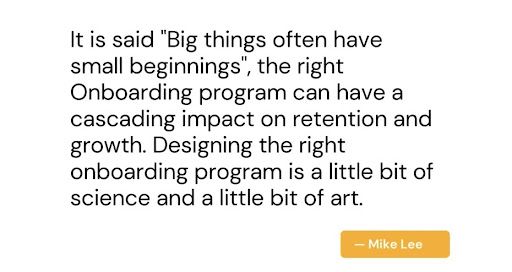
This is something I say periodically when I speak about onboarding.
The art comes from the fact every company has a different product, and how your customers start out using your product changes how your onboarding program works.
What I'm going to be talking about here is how do we use onboarding to further our mission and customer success? I personally believe without customer success, SaaS organizations cannot reach that billion dollar valuation or even move up from 50 million to 100 million.
You need customer success to help start that drive of value. In order to start that drive, you have to turn the key, and turning that key is that onboarding program.
Onboarding vs. preschool
Let's look at what onboarding is compared to preschool. Here in the US, we have a program that starts right before you go into grade school. The first grade in grade school is kindergarten, but right before then, at ages three all the way up to about four you're in a program called preschool.
The right foundations
Preschool starts these kids out in a way to where it's leveling the playing field, the foundational part of your education so when you go into grade school, kindergarten, first grade, second grade, and so forth, you have the tools you need to be successful.
There are 1000s and 1000s of studies about what happens when a child has proper preschool education and the benefits of it.
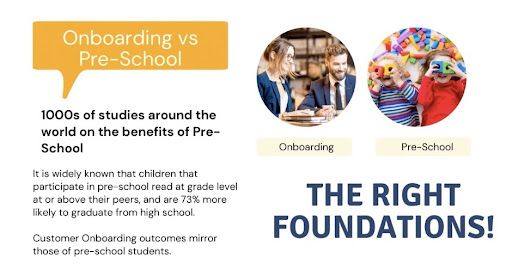
They're 73% more likely to graduate from 12th grade than their peers.
Why is that? Because preschool is technically an onboarding program. You're learning the alphabet, you learn the basics of reading, the basics of counting, you're learning how to socialize, how to share, how to ask for permission, how to stand in line, all these different things that allow you to be successful in school.
Customers are no different
When they start using your product, they have no idea what it takes to use your product. You can use the onboarding program itself to help them get the right foundation, and how to use your tool.
Or even how to reach out to other customers, how to manage the resources they have available to them, and knowledge basis, the documentation, the support system. Those sorts of things stack up to allow your customers to be successful.
So onboarding is extremely important if you're looking at the journey of your customer.
That's the space I want us to look at - the entire journey, not necessarily the tactical part, because inherently onboarding is tactical. You're doing transactional items in onboarding. But you're looking to move your customers for a long life cycle.
What happens if we look at onboarding slightly differently?
A lot of times, organizations have onboarding as the starting point, a start point for CSMs, or when you hire someone who doesn't have much customer success experience, they'll put entry-level people on the onboarding program, so you kind of kick that off, get that going, and so forth.
But let's flip it upside down, like our friend here looking at the world upside down.
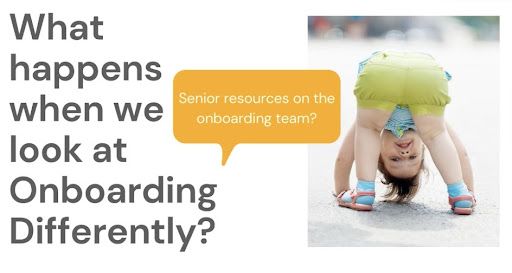
What happens if we look at that differently?
We all understand the onboarding program is one of the most essential parts of success in a customer's journey. If you get the onboarding part correct, if you set your customers out on the journey for success, there's a good chance their life cycle is going to be long with you, they're going to stay with you for a long time if they can get that first value.
Senior resources on the onboarding team?
So what happens if instead of our entry-level employees, some of our more senior employees were doing onboarding?
What is the value of a customer being able to get some of those more intricate and challenging questions they may have answered from a more seasoned resource?
At the very beginning, instead of getting into the program, using your product, and those basic or entry-level or first-level questions come up, what happens if we address that initially?
I personally believe we can flip that around and have the time to first value shortened if we can have someone with a little more experience in your organization do an onboarding.
It could be rotational. It doesn't have to be the only thing that these resources do. Obviously, we're going to need them in strategic spaces, we'll need them in enterprise spaces. But we don't want to forget the importance of onboarding. And if we get that right, we have successful customers.
Let me tell you a little bit about myself.
About me
Like I mentioned earlier, I am the Director of Customer Success at Spreedly. I recently became a published author, and the book, The HBCU experience actually is an Amazon bestseller. So I'm really excited about participating in that project. It's a really cool experience about my life in college and in the marching band in college.
I'm also an award winning cinematographer, I won a cinematography award at the Making Georgia Film Festival. The picture in the bottom right is me doing some of the work for which I won an award.
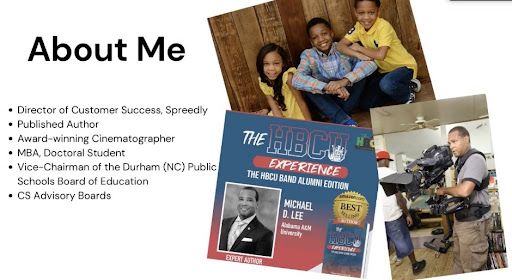
I'm carrying a steady cam there. So I have a passion about film, and things of that sort.
I have an MBA and I'm actually a doctoral student, I'm looking for my dissertation to be the moderating effects of customer success on SaaS valuations, and customer value.
I'm really excited about customer success. I'm really passionate about it.
I sit on the board of education here in Durham, North Carolina, and I sit on multiple advisory boards related to customer success, such as Gain, Grow, Retain - GGR.
What is onboarding?
So what is onboarding for those of us who don't have an onboarding program or those who came to understand a little bit more about what customer success is.
Create value quickly
Onboarding is a way to quickly create value. The one thing we want our customers to do is use our tools as fast as we could get there.
Setting expectations
We want to set expectations. This is extremely important. Sometimes salespeople over-promise some of the functionality. Sometimes customers don't know what to expect. But this is the opportunity to set those expectations of:
"This is what is going to happen, we're going to help you to value, you're going to use our tool that's going to make your life better. If we work together, we become partners, your career is going to take off, your company is going to save money, your employees are going to save time".
That's what we all hope for.
Reinforce goals
We reinforce goals, this is our time to really dig in and understand what the strategic priorities are for the organization.
How can we align our product with your strategic priorities? And even going a little deeper, what are your personal goals in your role? How can my product help you with that?
Build trust
And to build trust as customer success resources, we have to build trust with our customers.
This onboarding program is our opportunity to do just that. It's completely transparent, "This is what you're going to get. This is how I'm going to help you. This is how you contact me. Do you have any questions? If I can't answer your questions, I'm going to get someone there who can."
This is the beginnings of this relationship, this trusted adviser idea that is one of the pillars of customer success. This is where it starts. And it's very important to start that right off as fast as we can to get that going.
Because customers, they're unsure about your product. They just bought this product, they may have buyer's remorse, they may not know what to do with it.
But this onboarding program allows you to steady the waters and allow them to understand "It's okay, we're gonna get you there". That's what a good onboarding program can do.
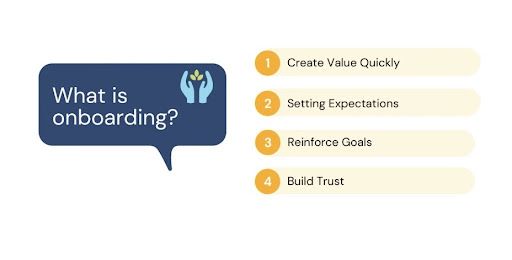
What onboarding is not
But let's talk about what onboarding is not.
A single engagement
It is not a single engagement. Let me say that again, onboarding is not a single engagement.
A lot of organizations have a kickoff call and in this kickoff call, you talk about different things, your resources, how you submit a support ticket, this is my contact information if you need me, etc, etc.
And after the kickoff call, that's it. Go on about your way. That can't be the case. If we go back to preschool, preschool is not one day. You're not going to learn the foundations of your product in one day. We have to rethink this in more of a strategic fashion.
Troubleshooting
We don't want to do troubleshooting in your onboarding program. Your onboarding program's to get them off. Now there are going to be some situations where technical resources may need to come in and answer a few questions if you're customizing your tool or so forth. But it's not a time for troubleshooting.
Implementation (well maybe)
This is a little bit of controversy and I'll touch on this here. Implementation versus onboarding. This could be a whole nother article.
Implementation
Implementation is more of a technical configuration and helping a customer get up to speed doing work, sitting on the phone, put this configuration in, you need to find this identification, you need to do this, connect this. It's more of a technical component.
Onboarding
Onboarding is more of an overall component where you're welcoming them into your product. But also, how do you get answers?
It's not about providing the answers, it's not about providing technical answers. It's about providing answers that are more resource-based, this introduction to the product itself.
A time to sell
And onboarding is not really a time to sell either. Onboarding is not really a place to hit a customer with, "Well, it'd be better if you bought this, it'd be better if you bought that" what we want to do is understand what they purchased, what they understand they purchased, and then how they use what they purchased to get the value they're expecting.
If there's something else they need, that's for a different conversation and not really onboarding, they need to speak to sales.
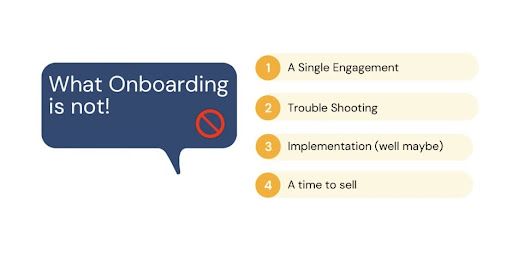
Onboarding with a strategic lens
Let's take a look at onboarding with a strategic lens. When we're trying to plan onboarding as strategic, we have to take a step back and we have to say:
- What does this piece of my puzzle have to do with the rest of the puzzle itself?
- How does it fit in for our revenue and other considerations?
- How does a successful customer impact revenue?
- Inversely, how does an unsuccessful customer impact revenue?
- What are the key outcomes of an early successful customer?
Take a step back and look at that, you start to develop a program to make sure those outcomes are seen as the customer starts to move out of onboarding.
What level of engagement do successful customers need? Everybody needs different levels of engagement.
Spreedly is an API based product so the customers we interact with are generally developers. A lot of times developers just need documentation. But also on the business side, business people need to understand the strategic use of payments.
That's what we as customer success professionals do at Spreedly. We need to understand:
- What does success look like for the different personas in your organisation?
- What can we take off customer success managers through onboarding? That goes back to some of those early questions that customers generally would have.
- How do we do that?
- How do we take that off CSMs, or how can we address items that will free up customer success managers later down the road after onboarding to do more proactive work? The success plans, the value driven conversations, the EBRs, the QBRs with these questions already answered.
Then a strategic program to affect the outcomes of your customers. This is the only view we as leaders have to think about here.
Now we have to design it from a strategic perspective, how does it affect the rest of the business? But inherently when we're on the ground, we're actually working with customers, that's a tactical conversation, those are tactical steps.
Those are success plans, those are check-in meetings, those are the milestones and things of that sort. It has to be tactical. But when we're planning a program, we need to take a step back and cast out our view a little further so that we understand what we're trying to accomplish.
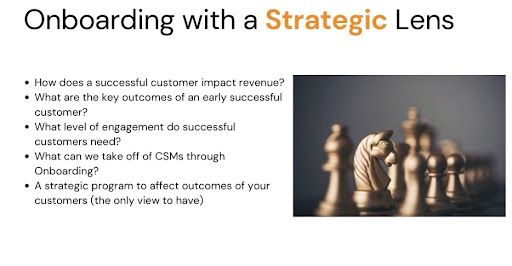
Where do we go from here?
We want to take a strategic look at onboarding. We want to define what outcomes must happen for the successful completion of the onboarding program.
So you can't necessarily say I want my onboarding program to be four weeks. That may not be enough. An onboarding program may have to be three months depending on your product. It could be two weeks, depending on your product. But you don't want to arbitrarily do that.
Start measuring onboarding with common KPIs and metrics
You want to define what successful completion of your onboarding program looks like.
- What needs to happen?
- Where does the customer need to be?
- Does it need to be first value before they're out of the onboarding program?
- Or can they be just about to see the first value?
That's what we have to look at. So, how do we measure the effectiveness of our onboarding program?
- Time to first value, obviously.
- Percent of customers who churn within three months, there are various reasons that can happen.
- Cost of onboarding program per customer allows us to capacity-wise make sure we're resourced correctly.
- Surveys.
- CSAT at the end of onboarding.
- NPS at the end of onboarding, or even
- CES, customer engagement score.
- How complicated is the product after they've been through an onboarding program?
- Do they understand the product?
- Usage, of course, and
- Milestones and levels that were hit.
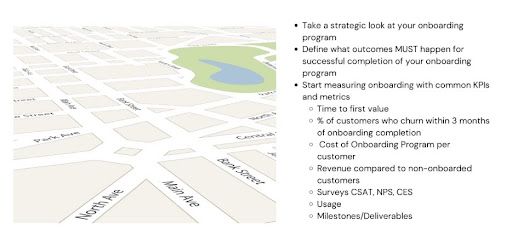
Re-onboarding
Now, I want to introduce this idea I've been toying around with - re-onboarding. I'm not talking about customers who come back, I'm talking about customers you've lost engagement with maybe, or maybe haven't been engaged in a little while since things may have changed.
What is re-onboarding?
Re-engagement
It's re-engagement at the highest strategic level, I believe. I'll use Spreedly as an example.
Spreedly has been around for a while and there are customers that use our product every day because of the payments, you kind of plug it in, let it work. But we've had new products come out in the last year or so. Our customers may not understand that.
This is an opportunity for us to do a re-onboarding program to say, "Hey, we're checking in, we have a new knowledge base, we have a new support system, we have this new product, that new product that could benefit your account. You've been looking to go into a new geography, we have new smart routing. You increase your gateways, we have network tokenisation now in Latin America".
All of those sorts of things that customers who are not engaged may not understand and we're setting out into a new direction of re onboarding these customers almost like they're brand new customers.
But resetting those strategic goals or strategic priorities that were initially set, making sure we're connecting through Spreedly. This is still going towards these goals, how can we align what you're trying to do with what we offer now? It's an extremely popular initiative.
Because we as customer success managers want engagement with our customers. That's what we want. That's what we live on. That's what we thrive on. And now we have a way to get in and say, "Let's reengage because we have new things to talk about. We haven't talked to you in a little while."
Re-onboarding campaign by segment
This can be done by segment. Obviously, you want your higher-value customers. But even on the digital touch side, even in the digital onboarding program that you create as part of your strategy, you're going to want to reach out.
You're going to want to make sure they understand "Here's the new things. Let's go back through here. Let me show you what you what you're missing here".
New functionality
And then new functionality. Obviously, when new products come out, when new features come out and you see customers who may not be using them, this is an opportunity to introduce that again.

Re-onboarding, think about that as your CSMs are looking to re-engage, as your products change, as your customer engagement for a particular customer goes stale.
Think about a strategic outreach or strategic program to re onboard those customers. That may help you to move forward and re-engage with that customer and maybe even get them more active in what you're doing.
Thank you.

